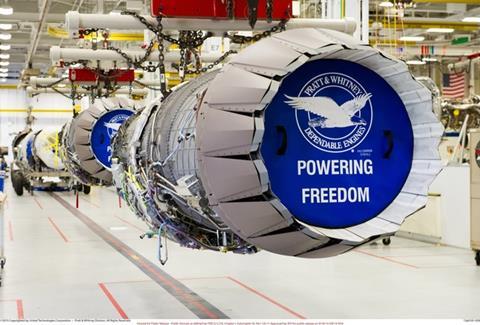Engine maker Pratt & Whitney (P&W) is moving forward with plans to upgrade powerplants on the USA’s fleet of Lockheed Martin F-35 stealth fighters.
The Raytheon Technologies subsidiary received an early $66 million contract from the US Department of Defense (DoD) to support initial activities for the Engine Core Upgrade (ECU) programme.

The funds will pay for design engineering efforts, technology maturation and long-lead material and hardware purchases for the ECU initiative, according to Raytheon, which aims to address a deficit of electrical power and cooling capacity with the F-35’s current P&W F135 engine.
“We will use this funding to make quick progress on our Engine Core Upgrade’s preliminary design efforts, and that will keep us on track to deliver this important capability starting in 2028,” says Jennifer Latka, P&W vice-president of F135 engines.
The ECU programme will cover the entirety of the USA’s F-35 fleet, which includes all three variants of the fifth-generation fighter serving across the US Air Force (USAF), US Navy (USN), and US Marine Corps (USMC).
While the current F135 engine is capable of supporting contemporary F-35 operations, improvements to the onboard sensor suite since the jet was designed have left the powerplant overtaxed and functioning outside its design specifications.
Although P&W maintains this is not an issue for short-term performance, both the engine maker and government auditors acknowledge the issue has substantially increased maintenance and sustainment costs.
In May, a US Government Accountability Office (GAO) report found that overtaxing F135 engines has already cost the DoD $38 billion in additional expenses.
The USAF has led the effort to address the F-35 power and cooling issue, exploring both an F135 core upgrade and an entirely new engine.
GE Aerospace pushed the government to field its new XA100 three-stream adaptive engine, citing substantial improvements in flight performance and increased thermal-management and power-generation capacity.
However, P&W and parent company Raytheon argue the ECU is a faster and more cost-effective means of achieving that outcome.
“The F135 ECU is the fastest, most cost-effective and lowest-risk path to Block 4 capability for all global F-35 operators,” Raytheon says. “It is optimised for all three F-35 variants and will yield $40 billion in life-cycle cost savings by avoiding disruptive and costly air vehicle changes and leveraging the current global sustainment infrastructure.”
GE has also argued its adaptive engine will generate life-cycle cost savings.
While the ECU is compatible with all conventional, carrier-launched and short take-off and vertical landing (STOVL) F-35 types, the new adaptive engine designs are incompatible with the F-35B STOVL variant and questions exist regarding its suitability for the F-35C carrier variant.
Those concerns, along with cost, led the USN and USMC to rule out funding an all-new engine. The 2024 presidential military budget request indicates support for the ECU across the services.
The Pentagon’s F-35 Joint Program Office (JPO), which oversees acquisition of the jet for the US military and overseas allies, reiterated the DoD’s support for the core upgrade in recent comments to FlightGlobal.
“The F-35 JPO stands behind our in-depth business case analysis, conducted in partnership with industry, that helped inform DoD’s decision to move forward with the F135 Engine Core Upgrade,” the office says.

Controversy erupted over the matter at the Paris air show in June, when a Lockheed executive voiced support for an adaptive engine solution over the ECU option. The incident triggered stern response from Raytheon and P&W, which accused Lockheed of impropriety by contradicting the Pentagon’s stated preference.
The aerospace giant had previously voiced a neutral stance on the matter.
Lockheed has since walked back from the Paris remarks, expressing support for the ECU and saying the company is “fully committed” to the engine modernisation effort.
“We will continue our partnership with government and industry to implement the US government’s decision to pursue the F135 Engine Core Upgrade and any future decisions to stay ahead of the evolving threat,” Lockheed says.
While the DoD and industry appear to be aligning behind the ECU option, lawmakers in Congress will have the final say when they approve the fiscal year 2024 defence budget.
The issue is set to be a point of contention, with some lawmakers expressing a preference for the thrust and fuel consumption improvements of an adaptive engine.
However, members of Congress from Connecticut – home to P&W and several other major defence manufacturers – are throwing support behind the ECU.
“Upgrading the F135 is the right decision to support our national defence priorities and defence industrial base, and I’ll continue to ensure this programme gets the support and funding it needs,” says Representative Rosa DeLauro, ranking member of the powerful appropriations committee in the House of Representatives.
P&W says the ECU improvements will provide adequate power and cooling improvements to address both current F-35 needs and the planned series of sensor and weapons upgrades known as Block 4.
However, analysis by GAO auditors found the F-35’s onboard power and thermal management system (PTMS) – made by Honeywell – will also need an upgrade to support any improvements to F-35 capability beyond Block 4.
While it functions in tandem with the F135 engine, the PTMS is a separate system that was not covered by P&W’s ECU plans. The Pentagon now acknowledges the Honeywell system will need an upgrade, regardless of how the engine issue is addressed.
“A PTMS solution is required by any engine option,” the JPO says.
P&W sister company Collins Aerospace – also a Raytheon subsidiary – has already unveiled a still-under-development alternative to the current PTMS, which it calls the Enhanced Power and Cooling System (EPACS).
Speaking at the Paris air show, Collins’ president of power and controls Henry Brooks said EPACS will provide more than twice the cooling capacity of the F-35’s Honeywell PTMS, based on initial test results.


























